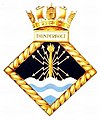HMS Thetis (N25)

HMS Thunderbolt
|
|
| History | |
|---|---|
|
|
|
| Name: | HMS Thetis |
| Builder: | Cammell Laird & Co Limited, Birkenhead |
| Laid down: | 21 December 1936 |
| Launched: | 29 June 1938 |
| Commissioned: | 26 October 1940 |
| Fate: | sunk during trial dive, 1 June 1939 |
| Badge: | |
| Refit: | raised and refitted, 1939–40 |
| Renamed: | HMS Thunderbolt |
| Recommissioned: | 1940 |
| Fate: | sunk 14 March 1943 |
| Badge: | |
| General characteristics | |
| Class and type: | T-class submarine |
| Displacement: |
|
| Length: | 275 ft (84 m) |
| Beam: | 26 ft 6 in (8.08 m) |
| Draught: |
|
| Installed power: |
|
| Propulsion: |
|
| Speed: |
|
| Range: | 4,500 nmi (5,200 mi; 8,300 km) at 11 kn (13 mph; 20 km/h) |
| Test depth: | 300 ft (91 m) |
| Complement: | 59 |
| Armament: |
|
HMS Thetis (N25) was a Group 1 T-class submarine of the Royal Navy which served under two names. Under her first identity, HMS Thetis, she commenced sea trials on 4 March 1939. She sank during trials on 1 June 1939 with the loss of 99 lives. She was salvaged, repaired and recommissioned as HMS Thunderbolt serving in the Atlantic and Mediterranean theatres until she was lost with all hands on 14 March 1943. This makes Thetis one of the few military vessels that have been lost twice with her crew in their service history.
Thetis was built by Cammell Laird in Birkenhead, England and launched on 29 June 1938. After completion, trials were delayed because the forward hydroplanes jammed, but eventually started in Liverpool Bay under Lieutenant Commander Guy Bolus. Thetis left Birkenhead for Liverpool Bay to conduct her final diving trials, accompanied by the tug Grebe Cock. As well as her normal complement of 59 men she was carrying technical observers from Cammell Laird and other naval personnel, a total of 103 men. The first dive was attempted at about 14:00 on 1 June 1939. The submarine was too light to dive, so a survey of the water in the various tanks on board was made. One of the checks was whether the internal torpedo tubes were flooded.
Lieutenant Frederick Woods, the torpedo officer, opened the test cocks on the tubes. Unfortunately, the test cock on tube number 5 was blocked by some enamel paint so no water flowed out even though the bow cap was open. Prickers to clear the test cocks had been provided but they were not used. This combined with a confusing layout of the bow cap indicators — they were arranged in a vertical line with 5 at the bottom (2,1,4,3,6, and then 5) and the "Shut" position for tube 5 on the dial was the mirror image of tube 6 above it — led to the inner door of the tube being opened. The inrush of water caused the bow of the submarine to sink to the seabed 150 ft (46 m) below the surface. How the outer door (bow cap) to Tube 5 became open to the sea is a question that will probably never be answered, Woods maintained that until at least 10 minutes before he opened the tube all the indicators were at "Shut".
...
Wikipedia


